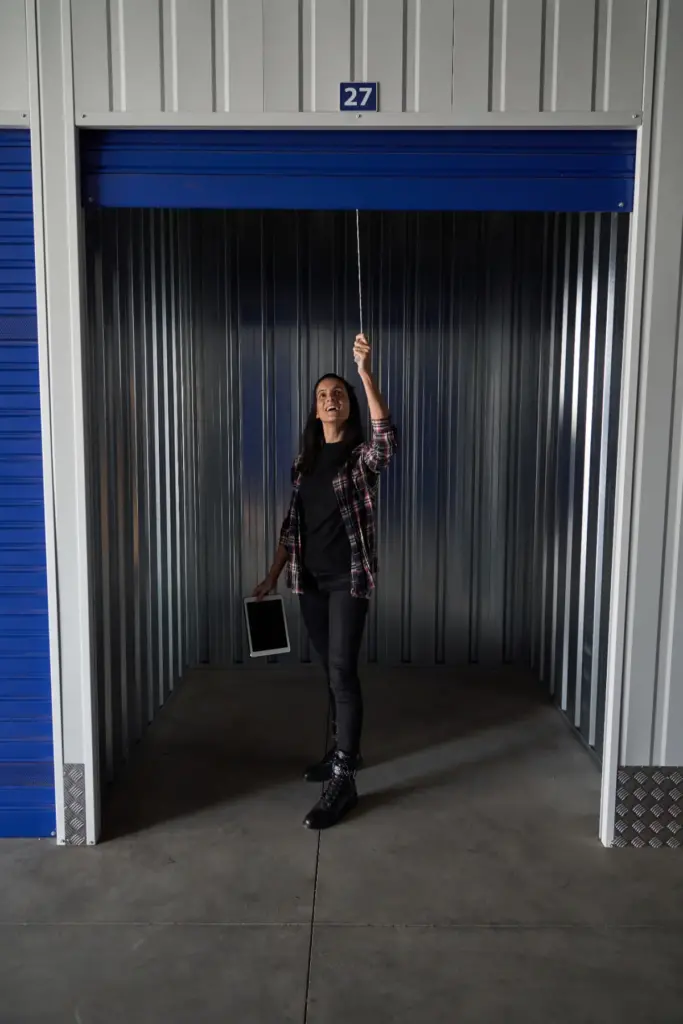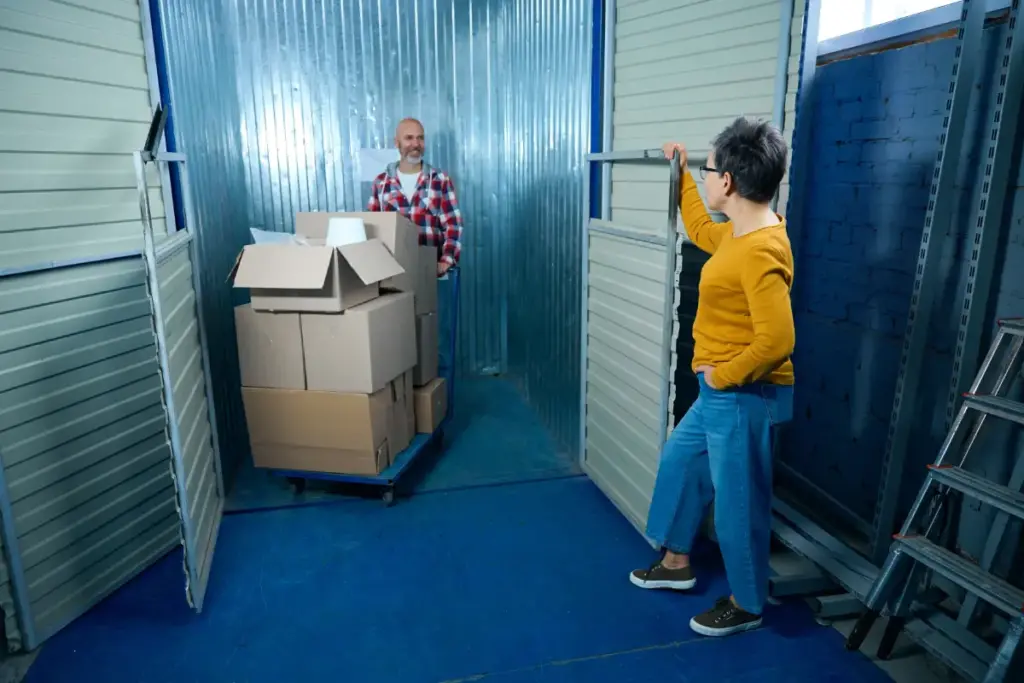Shipping containers have come a long way from being just a means of transporting goods between countries.
They are widely used for efficient storage solutions, and the popular 20ft and 40ft container sizes have been used by both individuals and companies to solve various storage challenges.
This guide will provide you with a comprehensive understanding of the practical dimensions and customization options available for these containers to help you make informed decisions for your storage and space transformation needs.

Understanding Container Basics: Sizes and Dimensions
Shipping containers have transformed the way we think about storing and utilising space. When it comes to standard containers, the dimensions are of the utmost importance.
The most commonly used shipping container dimensions, the 20ft and 40ft containers, provide basic measurements that seamlessly fit into the global logistics services network. However, what sets these two containers apart from each other?
Each type of container varies in width, height, and capacity, making it suitable for different purposes and projects. The 20ft container, which has an internal length of approximately 19’4″ and an interior width of around 7’8″, provides a compact storage solution.
On the other hand, the 40ft container doubles the convenience by doubling the interior length. The 40ft high cube containers, having the same width and a height of 9’6″, offer extra space, while standard containers are 8’6″ tall.
Container weight and volume are also essential considerations. A standard 20ft container can hold up to 33 cubic metres and a maximum gross weight of 24,000 kg. In comparison, a 40ft container can hold nearly 67 cubic metres and support a weight of up to 30,480 kg.
These specifications make shipping containers indispensable within the realm of storage and shipping.
The 20ft Container Dimensions
The 20ft container is a popular choice due to its versatility. It is one of the two most common container sizes and can be used for a variety of applications. Its dimensions make it ideal for maximising storage space, especially where larger containers may not fit.
Additionally, these containers can be efficiently modified to meet various needs while maintaining a balance between storage capacity and ease of handling. This versatility makes them a favoured option for urban projects and temporary installations.
At MIGHTY Self Storage in Leicester, we offer secure 20ft container storage equipped with state-of-the-art CCTV monitoring to ensure the safety of both personal and business items. Our 20ft container storage solutions are perfect for domestic and commercial storage needs, providing a secure, reliable, and flexible option whenever required.
40ft Shipping Containers
The 40ft container is an ideal choice when it comes to maximising storage capacity. It offers twice the storage potential of a standard 20ft container and is perfect for storing large quantities of goods, mobile construction offices, or spacious living quarters. The high cube version vary slightly as it is one foot taller than the standard version, making it well suited for voluminous needs.
The 40ft container is especially useful for businesses that need to export large inventories or store heavy machinery. Despite its formidable size, it can be customised to serve a variety of purposes, such as mobile medical units, refrigerated containers, or large-scale event spaces.
Customisation Opportunities
Containers are highly versatile and customisable and can be transformed into almost anything. From personal garden retreats to innovative startup headquarters, the 20ft and 40ft containers can be modified to suit your needs.
To begin customisation, it is important to determine the intended purpose and choose the appropriate size and dimensions. Modifications can include partition walls for better space management, additional doors and windows for better accessibility and lighting, and insulation for comfortable living.
Factors to Consider When Choosing A Container Storage: Making the Right Choice
The physical state of a container significantly influences its purpose. Selecting the ideal size shipping container storage is a pivotal decision that influences the cost effectiveness of storing your valuables and the safety.
Storage Capacity and Space Requirements
One of the most crucial factors when choosing a container storage solution is the amount of space you need. A 20ft container offers 33 cubic meters of storage, making it ideal for household items, office equipment, or business inventory. On the other hand, a 40ft container provides double the space, with a storage capacity of 67 cubic meters, making it good for large-scale storage needs, construction materials, or bulk inventory.
At MIGHTY Self Storage, we offer secure 20ft container storage for both personal and business use, ensuring that your belongings are kept safe and accessible whenever needed.
Cost Efficiency and Budget Considerations
Budget plays a significant role in selecting the right storage solution. 20ft containers are more cost-effective, making them suitable for short-term and long-term storage needs without the high expenses associated with larger units. In contrast, 40ft containers are more expensive but provide greater storage capacity per square foot, which can be advantageous for businesses needing to store large volumes of stock.
At MIGHTY Self Storage, we offer competitive pricing and flexible rental contracts, ensuring you get the best value for your storage needs.
Accessibility and Location Constraints
Before choosing a container, consider where it will be placed. A 20ft container is compact and fits easily into tight spaces, making it the ideal option for homes, businesses, and commercial properties. A 40ft container requires more space and may not be suitable for locations with access restrictions. If space is a concern, a 20ft container is the most practical choice.
If space is limited, we offer secure on-site storage options with easy access for trucks and forklifts, ensuring a hassle-free storage experience.
Handling and Transportation Needs
The 20ft container is lightweight and easy to transport, making it an excellent choice for frequent moves or short-term relocations. It can be easily loaded onto trucks and repositioned as needed. 40ft containers, due to their size and weight, require larger trucks and specialized handling, making them less flexible for quick relocations but ideal for long-term, high-volume storage.
At MIGHTY Self Storage, we provide seamless collection and delivery services, ensuring your container is placed exactly where you need it.
Security and Durability
Both 20ft and 40ft corrugated steel containers are built with high-strength materials, offering excellent protection against weather, theft, and vandalism. Reinforced doors and lock systems provide additional security.
At MIGHTY Self Storage, all our containers come with 24/7 CCTV monitoring, secure perimeter fencing, and controlled access, ensuring your items remain protected at all times.

Choose MIGHTY Self Storage for Your Container Storage in Leicester
When it comes to secure, affordable, and reliable container storage, MIGHTY Self Storage is the trusted choice in Leicester. Our 20ft steel storage containers are built for maximum durability, providing safe storage for businesses, homeowners, and commercial clients.
Whether you need short-term or long-term storage, we offer flexible rental agreements to suit your needs. Our facility is equipped with state-of-the-art CCTV monitoring, high-security perimeter fencing, and controlled site access, ensuring your valuables are protected at all times.
With our hassle-free collection and delivery service, we make storage easy and stress-free. Whether you are storing furniture, business stock, or personal belongings, we provide a cost-effective, secure, and customer-focused solution.
Experience affordable, secure, and flexible storage with MIGHTY Self Storage. Contact us today for a free quote.
Frequently Asked Questions
What are the two most common shipping container sizes and their uses?
The two most common container sizes, 20ft and 40ft, are standard shipping container sizes. These sizes have diverse applications in shipping, storage, and business. Their dimensions, including height and capacity, make them versatile options for various purposes.
What are ISO containers?
ISO containers are standardised shipping units built to global specifications, ensuring uniformity in size and structure. They include dry containers commonly used for general cargo and storage.
How do external and internal dimensions affect dry containers?
External dimensions determine transport and placement, while internal dimensions define usable space. For example, a 20ft dry container’s internal dimensions (approx. 19’4″ x 7’8″ x 7’10”) provide the actual storage area, making it ideal for various needs.
What role does size play in determining the purpose and capacity of shipping containers?
Container size directly influences capacity and purpose. Larger containers, like 40ft, maximise capacity and are suitable for shipping and storing larger items. Smaller containers, like 20ft, are versatile, fitting various sizes and purposes in business and storage.
Conclusion
Shipping containers, particularly the 20ft and 40ft sizes, offer versatile, durable, and cost-effective solutions for storage and logistics. Whether you need compact storage for personal items or expansive space for business inventory, understanding their dimensions, capacity, and customisation options ensures you make the right choice.
At MIGHTY Self Storage in Leicester, we provide secure, affordable, and flexible container storage tailored to your needs. With state-of-the-art security features and hassle-free services, your belongings are in safe hands. Contact us today to find the perfect storage solution for your requirements.
